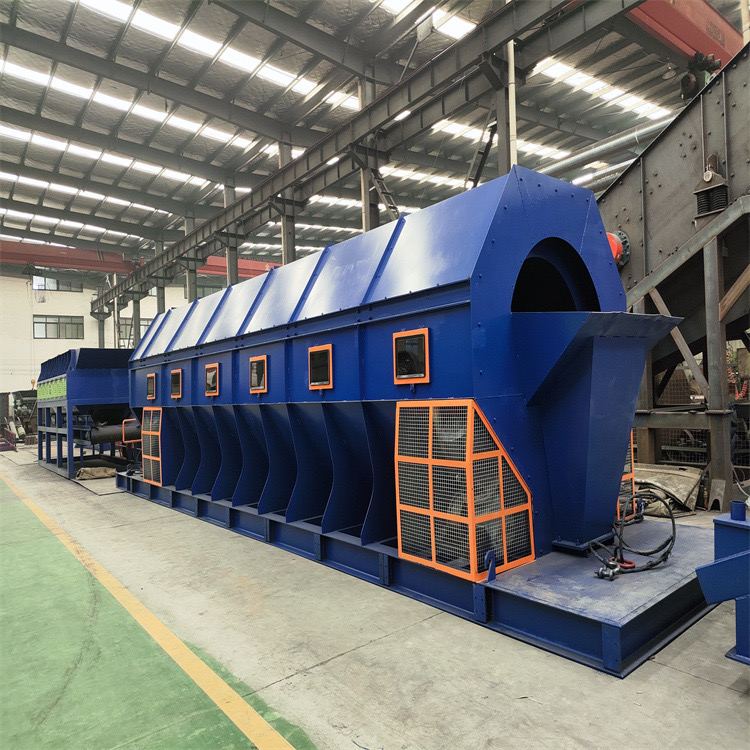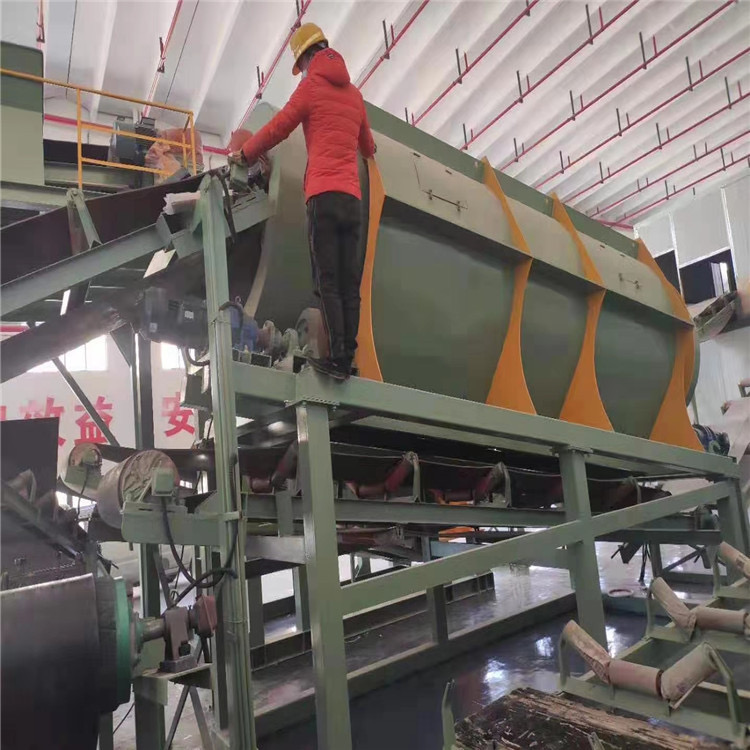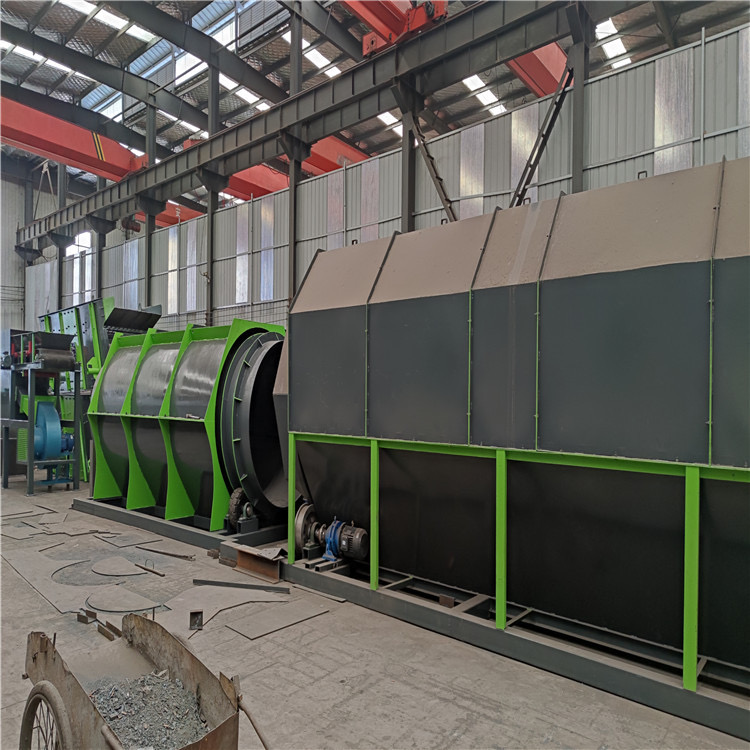The drum screen improves the efficiency of garbage sorting
In the modern world, waste management has become an essential component of environmental sustainability. With increasing amounts of waste generated globally, efficient waste sorting technologies are critical to managing this issue effectively. Among the various technologies available, drum screens, also known as trommel screens, stand out as a versatile and effective solution for sorting and separating materials in waste management facilities. This article delves into the workings, applications, and benefits of drum screens in the context of waste sorting.
The Basics of Drum Screens
A drum screen is a cylindrical device that rotates to separate materials based on size. The cylinder, or drum, is perforated with holes or mesh, allowing smaller particles to pass through while larger particles continue to move through the drum until they are either discharged or further sorted. The drum is typically inclined, which helps in moving the material through the screen, and the speed of rotation can be adjusted depending on the material being processed.
The design of a drum screen is simple yet highly effective. The material is fed into the drum at one end, and as the drum rotates, the material is lifted and dropped repeatedly. This action causes smaller particles to fall through the holes in the drum, while larger particles move towards the discharge end. The size of the holes or mesh can be customized to achieve the desired separation.

How Drum Screens Work in Waste Sorting
The operation of a drum screen in waste sorting involves several stages. First, the waste material is loaded into the drum, either manually or using conveyors. As the drum rotates, the waste is agitated, and the separation process begins. The design and settings of the drum screen can be adjusted to optimize the sorting process for different types of waste.
Initial Screening: The first stage in the drum screen process is the initial screening, where the material is separated based on size. Smaller particles, such as soil, sand, and small organic materials, pass through the perforations in the drum. These smaller fractions are typically collected for further processing, such as composting or energy recovery.
Separation of Recyclables: Larger materials, including plastics, metals, and glass, continue to move through the drum. Depending on the configuration of the drum screen, these materials can be sorted into different streams for recycling. For example, ferrous metals can be separated using magnets, while non-ferrous metals can be sorted using eddy current separators downstream of the drum screen.
Discharge of Oversized Materials: Materials that do not pass through the drum screen are discharged at the end of the drum. These oversized materials may include bulky items, large plastics, or other non-recyclable waste. In some cases, these materials are subjected to further processing, such as shredding or manual sorting.
Applications of Drum Screens in Waste Management
Drum screens are used in a variety of waste management applications due to their versatility and efficiency. Some of the key applications include:
Municipal Solid Waste (MSW) Management: Drum screens are widely used in municipal solid waste management to separate organic waste from recyclables. By screening out smaller organic particles, drum screens help in the production of compost and reduce the volume of waste sent to landfills.
Composting Operations: In composting facilities, drum screens are used to produce uniform compost by removing contaminants and oversize materials. The drum screen ensures that the compost is free of unwanted materials, improving the quality of the final product.
Recycling Plants: Drum screens play a crucial role in recycling plants by separating different types of recyclable materials. For example, they can be used to separate glass from plastics or metals, making the recycling process more efficient and cost-effective.
Mining and Quarrying: While drum screens are primarily used in waste management, they are also employed in the mining industry to separate ore from debris. The robust design of drum screens makes them suitable for handling heavy and abrasive materials.

Advantages of Using Drum Screens
Drum screens offer several advantages over other types of screening equipment, making them a popular choice in waste sorting facilities. Some of the key benefits include:
High Throughput: Drum screens can process large volumes of material quickly and efficiently, making them ideal for high-capacity operations. The continuous rotation of the drum allows for a steady flow of material, reducing bottlenecks and improving overall productivity.
Durability and Low Maintenance: Drum screens are designed to withstand harsh operating conditions, including exposure to moisture, abrasive materials, and varying temperatures. The robust construction of drum screens minimizes the need for frequent maintenance, reducing downtime and operating costs.
Versatility: One of the most significant advantages of drum screens is their versatility. They can be used to process a wide range of materials, from fine organic waste to bulky recyclables. This flexibility allows waste management facilities to adapt the drum screen to different types of waste streams, enhancing the overall efficiency of the sorting process.
Effective Separation: Drum screens provide effective separation of materials based on size, ensuring that different waste streams are properly sorted for further processing. The ability to adjust the size of the perforations in the drum allows for precise control over the separation process, improving the quality of the sorted materials.
Reduced Environmental Impact: By improving the efficiency of waste sorting, drum screens contribute to reducing the amount of waste sent to landfills. This, in turn, helps in minimizing the environmental impact of waste management operations. Additionally, the separation of recyclable materials helps in conserving natural resources and reducing the carbon footprint associated with waste disposal.

Challenges and Considerations
While drum screens offer numerous advantages, there are some challenges and considerations to keep in mind. For instance, wet or sticky materials can sometimes clog the perforations in the drum, reducing the efficiency of the screening process. Regular maintenance and cleaning are required to prevent blockages and ensure smooth operation. Additionally, the initial cost of drum screens can be higher than other types of screening equipment, although the long-term benefits often outweigh the upfront investment.
Conclusion
Drum screens are an essential component of modern waste sorting operations, offering a reliable and efficient solution for separating materials based on size. Their versatility, durability, and high throughput make them ideal for a wide range of applications, from municipal solid waste management to recycling and composting. By improving the efficiency of waste sorting, drum screens contribute to more sustainable waste management practices, helping to reduce the environmental impact of waste disposal and promote the recovery of valuable resources.
-
 Trommel screenTrommel screen, also known as drum screens, are widely used in various industries for sorting and separating materials.Get Quote
Trommel screenTrommel screen, also known as drum screens, are widely used in various industries for sorting and separating materials.Get Quote -
 Crop straw double shaft shreddApplications:Biomass Energy Production: Shredded straw can be used as a feedstock for bioenergy plants to produce electricity or heat.Livestock Feed: Reduced-si...Get Quote
Crop straw double shaft shreddApplications:Biomass Energy Production: Shredded straw can be used as a feedstock for bioenergy plants to produce electricity or heat.Livestock Feed: Reduced-si...Get Quote -
 Zhongcheng Air Drum SeparatorAir drum separators effectively separate lightweight materials (e.g., plastics, paper) from heavier materials (e.g., metals, glass). This high efficiency is cru...Get Quote
Zhongcheng Air Drum SeparatorAir drum separators effectively separate lightweight materials (e.g., plastics, paper) from heavier materials (e.g., metals, glass). This high efficiency is cru...Get Quote
-
2024-08-07Efficient Material Separation with Bounce ScreensThe ballistic separator is an important equipment with separation function designed for the sorting of inorganic particles in the coarsely crushed waste.
-
2023-01-12Horizontal Semi-Auto Hydraulic BalerSemi automatic balers are used across the logistics, recycling and manufacturing sectors to process large volumes of waste materials such as cardboard, film, pa...
-
2024-06-09Drum Screen RecyclingDrum screen machines are primarily used for material screening, helping to sort and recycle municipal solid waste and screen landfill waste. Their efficiency an...
-
2024-04-13Vibrating FeederA vibrating feeder is a mechanical device used to convey materials, typically in bulk, from one location to another in a controlled manner. This equipment is co...
-
2024-08-07Tire double shaft shredderOperation:Feeding: Whole or pre-cut tires are fed into the shredder through an inlet hopper.Shredding: As the tires enter the shredding chamber, the rotating cu...



